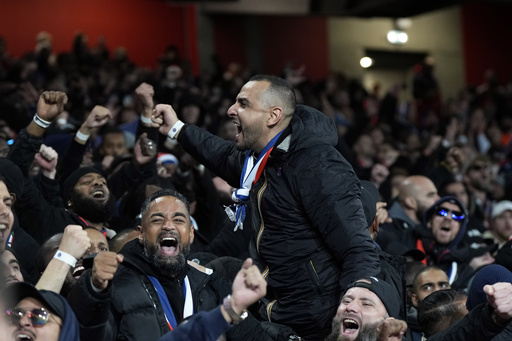
“`html
PARIS — The soccer landscape in the City of Light is set to experience a transformative makeover with the arrival of billionaire Bernard Arnault and Red Bull, who are taking the reins of Paris FC.
Agache, the holding company managed by the Arnault family, made an announcement on Thursday declaring itself the primary shareholder of the club, while the well-known energy drink brand will hold a minority interest. The financial backing from Arnault, the CEO of luxury conglomerate LVMH, is anticipated to facilitate the rise of a competitive alternative to Paris’ premier club, Paris Saint-Germain (PSG).
A Unique Situation in Paris
In contrast to many other European cities where fans enjoy the luxury of multiple top-tier teams to support, Paris has remained an exception for years. For instance, while the Premier League showcases seven clubs from London for the current season, the French capital is dominated by the Qatari-owned PSG, which stands as the sole significant club.
This is a somewhat unusual occurrence in the realm of European soccer, as major cities like Madrid, Rome, Barcelona, Milan, as well as Lisbon and Manchester typically boast two or more high-profile teams. The significant absence of rival clubs has led to PSG’s unique dominance.
“There’s a paradox. We have a very popular sport that produces great soccer players but for the moment has not produced great clubs in Paris,” says Paul Dietschy, an expert in the cultural and political history of sports. He pointed out that the Seine-Saint-Denis region, located just north of the capital, serves as a major scouting ground for Europe’s top clubs yet has not been able to produce long-lasting clubs comparable to those in major cities such as Madrid and London.
Previous Investment Attempts
This development is not the first time significant financial resources have been directed into a Parisian club. The late French media magnate Jean-Luc Lagardère previously sought to restore the fortunes of the city’s former leading team, Racing Club, by launching Matra Racing in the 1980s. Lagardère sought marquee players—like Uruguayan star Enzo Francescoli and German ace Pierre Littbarski—in a bid to rival PSG.
Although the venture initially showed promise, Matra ultimately faced difficulties in garnering fan support, resulting in poor outcomes both on and off the pitch, leading Lagardère to withdraw his investment after just a few short years. A variety of other teams from Paris, such as Red Star, have also faded from prominence over the years. While Red Star has a dedicated working-class support and has returned to the second division, a lack of stability has kept it shrouded in obscurity for decades.
National Team Success Amid Club Challenges
The struggles to maintain elite soccer clubs in Paris and throughout France stem from a complicated history with the sport in the nation. Historically, French soccer has been slow to rise to prominence, lagging behind other sports such as cycling, which captured public attention during the early 20th century.
“The post-World War II period saw a disconnect between French capitalism and soccer,” noted Dietschy. The nationalized economy meant fewer major corporations capable of backing soccer clubs, further contributing to the stagnation.
Numerous sports options within Paris, along with political dynamics in the suburbs, contributed to soccer’s underwhelming national identity. While the national squad has achieved considerable success, including four major titles, the domestic league has struggled with consistent fan engagement.
PSG, since its Qatari acquisition in 2011, has overshadowed all local competitors, dominating French soccer by winning the Ligue 1 title in an impressive ten out of the last twelve seasons. While other clubs like Monaco and Lille have enjoyed occasional successes, PSG’s stranglehold on the title emphasizes the disparity.
A Country with Potential Talent
Despite a lack of elite club presence, France is well-known for its exceptional youth academies, which are regarded among the best globally alongside Brazil and Spain. These academies are responsible for producing numerous talents, such as 2022 Ballon d’Or recipient Karim Benzema and star forward Kylian Mbappé.
However, the nation’s soccer structure remains more influenced by grassroots talent identification than immediate competitive success. Apart from Marseille’s historic Champions League triumph in 1993, very few French outfits have made a mark on the international stage despite the country’s strong youth scouting networks.
French soccer retains a sizable base, with over two million individuals affiliated with clubs, but interest in Ligue 1 has fluctuated. Compared to passionate English fandom, French fans exhibit a more casual connection to club soccer. While national heroes have emerged, the lasting impact on club affiliation remains limited to a select few teams, such as Marseille and Saint-Etienne.
A Brief Resurgence Followed by Decline
During the 1980s and 1990s, interest in the French league peaked when dynamic clubs like Marseille boasted star-studded rosters. However, the Bosman ruling in 1995 drastically changed the landscape by permitting an influx of foreign talent to higher-paying leagues, resulting in an exodus of French players.
It wasn’t until PSG’s emergence as a powerhouse, thanks to more than a billion euros invested by Qatari owners since 2011, that the league regained any semblance of financial strength. Despite attracting global stars like Neymar and Lionel Messi, PSG has yet to capture a Champions League title.
The future of Paris FC, under the direction of Arnault’s group, presents a hopeful outlook. “The Paris FC business can work, because there are no more seats left at the Parc des Princes to see PSG,” remarked Dietschy. Although Paris FC lacks a storied history, there is potential for a new identity to be forged in the evolving landscape of French soccer.
“`
